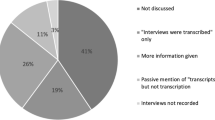Abstract
This paper shows how to carry out quantitative narrative analysis (QNA) with different text analysis software (PC-ACE, Program for Computer-Assisted Coding of Events, and various CAQDAS programs, Computer-Assisted Qualitative Data Analysis Software: ATLAS.ti, MAXQDA, and NVivo). QNA is a methodological approach to narrative texts that exploits invariant properties of narrative (namely, a “story grammar”, based on actors, actions, and their attributes) to make a statistical analysis of words possible. In comparing PC-ACE and CAQDAS, the paper leads the reader through the steps involved in setting up a grammar, in data entry, and in data query. A careful comparison of limits and possibilities of the two types of software will allow the reader interested in QNA to make an informed choice between a full implementation of QNA in a specialized but unknown software (PC-ACE) and a limited implementation in any of the widely used and popular CAQDAS programs.
Similar content being viewed by others
References
Abell P.: Narrative explanation: an alternative to variable centered explanation?. Annu. Rev. Sociol. 30, 287–310 (2004)
Alexa M., Zuell C.: Text analysis software: commonalities, differences and limitations: the results of a review. Qual. Quant. 34(3), 299–321 (2000)
Beck W., Tolnay S.: The killing fields of the deep south: the market for cotton and the lynching of blacks, 1882–1930. Am. Sociol. Rev. 55, 526–539 (1990)
Carley K.: Coding choices for textual analysis: a comparison of content analysis and map analysis. Sociol. Methodol. 23, 75–126 (1993)
De Fazio, G.: Political radicalization in the making: the Civil Rights Movement in Northern Ireland, 1968–1972. Doctoral Dissertation, Sociology Department, Emory University (2011)
Doyle, S.: “Stories most of all”: a content analysis of bestselling children’s books in Britain (1964–2004). Doctoral Dissertation, Sociology Department, University of Oxford (2009)
Friese, S.: Using ATLAS.ti for analyzing the financial crisis data. Forum: Qual. Soc. Res. 12(1) (2011). http://nbn-resolving.de/urn:nbn:de:0114-fqs1101397
Franzosi R.: From Words to Numbers: Narrative, Data, and Social Science. Cambridge University Press, Cambridge (2004)
Franzosi R.: Content Analysis. Benchmarks in Social Research Methods Series (Quantitative Applications in the Social Sciences), 4 vols. Sage, Thousand Oaks (2008)
Franzosi R.: Quantitative Narrative Analysis. Quantitative Applications in the Social Sciences Series. Sage, Thousand Oaks (2010)
Franzosi, R.: Narratives and networks: mapping social relations during revolutionary periods (Italy, 1919–1922). Unpublished manuscript, currently under Journal Review (2011)
Franzosi, R.: On quantitative narrative analysis. In: Holstein, J.A., Gubrium, J.F. (eds.) Varieties of Narrative Analysis (pp. 75–98). Sage, Thousand Oaks (in press)
Franzosi, R., De Fazio, G., Vicari, S.: Ways of measuring agency: an application of quantitative narrative analysis to lynchings in Jim Crow South. Unpublished manuscript, currently under Journal Review (2011)
Halliday, M.A.K.: An Introduction to Functional Grammar. London: Arnold (1994/1985)
Junker, A. (2012) The persistence of gods and emperors: the Chinese Democracy Movement and the Falun Gong. Doctoral Dissertation, Sociology Department, Yale University
Lewins A., Silver C.: Using Software in Qualitative Research: A Step-by-Step Guide. Sage, London (2007)
Markoff J., Shapiro G., Weitman S.: Toward the integration of content analysis and general methodology. Sociol. Methodol. 6, 1–58 (1975)
Podolny J.M., Hill-Popper M.: Hedonic and transcendent conceptions of value. Ind. Corp. Change 13(1), 91–116 (2004)
Popping R.: Computer-Assisted Text Analysis. Sage, Thousand Oaks (2000)
Vicari, S.: Contemporary protest: the online framing of local and global dynamics. Doctoral Dissertation, Sociology Department, University of Reading (2008)
Author information
Authors and Affiliations
Corresponding author
Electronic Supplementary Material
The Below is the Electronic Supplementary Material.
Rights and permissions
About this article
Cite this article
Franzosi, R., Doyle, S., McClelland, L.E. et al. Quantitative narrative analysis software options compared: PC-ACE and CAQDAS (ATLAS.ti, MAXqda, and NVivo). Qual Quant 47, 3219–3247 (2013). https://doi.org/10.1007/s11135-012-9714-3
Published:
Issue Date:
DOI: https://doi.org/10.1007/s11135-012-9714-3




